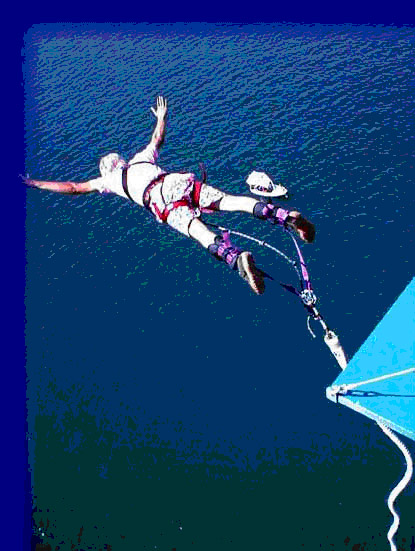PREVENTION OF INJURY IN SPORTS


Introduction
Bungee Jumping is not a new practice. Indians in the South Pacific island of Pentecost used to have a kind of a competition or rite which the males jumped from banyan trees tied to vines. Since this practice was shown in 1955 by a National Geographic documentary , bungee jumping has gained world wide popularity. It was recognized as a sport in 1979.
The literature about injuries and deaths about this sports is not enough to take full conclusions about the theme. Over two 2 million people have jumped since 1987 . In 1992 it was reported 5 deaths and 4 critical injuries. There is a lack of data about how many accidents, and in which circumstances, had occurred until today.
Physiology of Bungee Jumping
A bungee jump can be separated on three different stages: Free fall, Body deceleration, and Upward movement.
First Stage - Free fall . During this stage, all jump stress hormones, like beta-endorphin, growth hormone, prolactin, testosterone,and adrenalin , are supposed to be released. Several evidences obtained from monitoring jumps, show that it really occurs and it could explain the feelings of exhilaration and well being that often occurs and last for some days after a single jump. The theory that prolonged rises in brain neurotransmitter concentration can occur is being studied.
Second Stage - Body deceleration. A sudden body deceleration occurs because the elastic property of the cord ( Hook’s law- F=KX) . The intensity of deceleration depends on the kind of cord used and the altitude of the jump. The more intense decelaration the more is the risk of injuries. At this stage an increasing head ward fluid shift take place , consequently the hydrostatic pressure in the blood vessels of eye becomes dangerously high. Because the head-down position a sudden rise in intrathoracic pressure also occurs and it is one of the major damage event.
Third Stage- Upward movement. It is characterized by an upward movement in a head-down position. It is responsible for a further increasing in intrathoracic and head blood vessels pressures. According to some aviation studies, forces exceeding -3g (it is frequently reached during a bungee jump) are able to cause hemorrhages. Furthermore, an extreme bradycardia can occurs leading to syncope. The mechanism is supposed to be mediated for baroreceptors when a sudden and substantial headward shift of blood volume occurs .
Injuries
The increased popularity of this sport has raised questions about safety and risk of jumping ; as well as the risk that people who jump are exposed to injuries.
The major bungee jumping injuries have been impact related. Minor injuries include contusions, pinched fingers , and cord burns to the body. Intraocular hemorrhages, peroneal nerve injuries, near hanging , and quadriplegia are more serious injuries that are being reported. However, there are not reviews that compiled the wide range of injuries, identifying the risks (immediate and potential) of bungee jumping which would allow a better understanding of the risks.
The injuries are divided in three major groups : head, trunk, and lower extremities injuries.
Head - The head injuries have resulted in extensive damage to the eyes involving the retina and others structures such as fovea, macula, and internal limiting membrane , as well as the vitreous body and conjunctiva. In the most of cases, a temporary visual impairment is the result of these injuries. Reported injuries include nasal and temporal bilateral subconjunctival hemorrhages, subconjunctival chemosis (infection), and bilateral multiple parafoveal dot and blot hemorrhages .
Numerous spots in the eye are frequent to occur after a jump in the macular area. It is , probably, due to microinfarction resulting from blood vessel obstruction of the retinal nerve fibre layer. Other injuries less reported are blind spot, subinternal limiting membrane hemorrhaged of the macular region, and ruptures of the internal limiting membrane.
The most common fatal accident occurs when the individual becomes entangled with the cord. The body is suspended by neck and compression of trachea , carotid arteries, jugular veins, and cervical vertebras leads to a severe asphyxia , consciousness decline , and death. An example of it had recently occurred during the preparations for the last half time SuperBown show. An experienced bungee jumper, a woman, died suspended during the training before the presentation. This is more common in acrobatic jumping.
The miscalculation of the elasticity of the bungee cord may allow the impact of the head with the bungee pad to occur which is frequently fatal.
Trunk - The trunk injuries can be divided in three distinct categories : shoulder, back, and spine injuries. The shoulder injuries are dislocations and soft tissues damage as occurs in back injuries.
Spinal injuries reported had serious consequences, fortunately they are limited in number. Trauma has involved cervical spine, resulting in compression fractures , near-hanging, and quadriplegia. Damage to spine had typically involved the cervical facets and posterior spinous processes of vertebra, and intervertebral bodies and subaracnoid spaces between vertebrae. Abrasions, ecchymosis around the neck and minimal oedema result from near-hanging, C5 tenderness with decreased range of motion and bending of the neck have also been reported. In addition , it may occur acute neck pain, inability to move the legs and loosing of sensibility at and bellow cervical damage.
C2, C3, C5, C6, C7 neural injuries have been reported and the consequences of it include slightly decreased strength in the muscles of army, hands, and back , flaccid muscles in the lower extremity, and absence of deep reflex.
Further injuries in cervical spine resulting from bungee jumping and possibly attributed to the extreme forces that jumpers are exposed include : articular subluxation, small facet fractures, spinal cord contusion, and herniated nucleus pulposus.
Lower extremities- The peroneal (fibular) nerve injury is frequently involved in bungee jumping. This damage leads to a cutaneous anesthesia of the lateral aspect of the leg , foot, and ankle, as well as marked weakness in dorsiflection and eversion of the foot. These are the classical signs and symptoms of peroneal nerve palsy. The excessive traction on the nerve is the probable reason for the palsy.
Conclusions
Bungee Jumping results in a wide range of injuries owing the nature of the sport. Additional risk is present when there are lack of experience and faulty equipment. The effects of acceleratory forces on the body should be examined more closely, to determinate , for example, whether distance dropped or tensile strength of the bungee cord need to be modified as well as the equipment should be examined in its reliability and tension , in order to establish more consistent equipments and possible reduce risks. Formalized regulations should be established with specific standards and guidelines on equipment and practices.
Serious injuries to head, trunk, and lower extremities resulting from bungee jumping often leading to permanent sequels have been documented. There is a poor literature about this sport and general population may not be aware of risks. Although estimating the risk of a single jump is not possible , it depends on several factors as the weight ,age ,personal skill ,equipment and many others factors.
Thus, others studies are needed. A very powerful industry is given support to this sport, but safety must be the principal issue. The development of new equipment designs or variations of the sport should be thought since a lot of fun and adventure could be experienced in this extreme sport.
